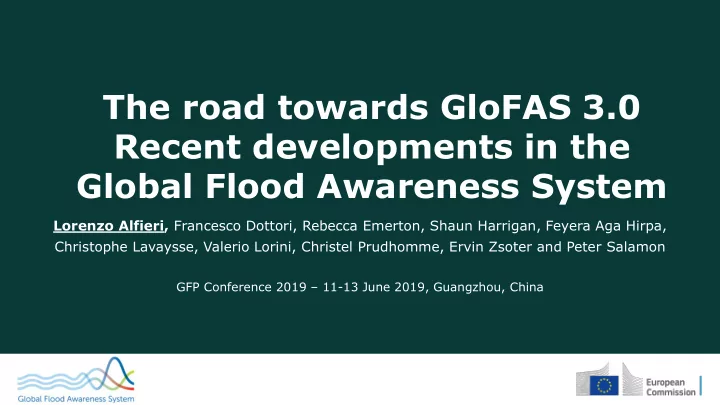

The road towards GloFAS 3.0 Recent developments in the Global Flood Awareness System Lorenzo Alfieri, Francesco Dottori, Rebecca Emerton, Shaun Harrigan, Feyera Aga Hirpa, Christophe Lavaysse, Valerio Lorini, Christel Prudhomme, Ervin Zsoter and Peter Salamon GFP Conference 2019 – 11-13 June 2019, Guangzhou, China
The Global Flood Awareness System GloFAS is an operational system for flood early detection It provides ensemble streamflow forecasts for the future 30 days in all the world’s large rivers Jointly developed by JRC & ECMWF with support from national hydro-met services and universities Daily runs since 2011 in pre-operational mode Used by development agencies, international aid organizations, DG ECHO ERCC, national hydro- met services, private sector (e.g. insurance). Currently more than 3000 registered users. http://www.globalfloods.eu
GloFAS and the Copernicus Programme Copernicus is the European Union's Earth Observation Programme Mapping Early warning Floods (EFAS, GloFAS ) Droughts (EDO, GDO) Forest fires (EFFIS, GWIS)
Schematic view Hydrological model Output Input data Global spatial HTESSEL + LISFLOOD River streamflow forecast information 2, 5, and 20 year flood return periods ERA5 ENS Land runoff ECMWF-ENS Flood warnings Grid resolution: 0.1 ° (~ 10 km) Temporal Ensemble weather resolution: 1 day predictions (51 members) (Alfieri et. al, HESS 2013)
Floods in Bangladesh – August 2017 Monsoon rains caused landslides and floods that killed about 1300 people and affected over 45 million people across India, Nepal and Bangladesh. GloFAS forecasts 28 July: signs of a potential major event, 12 to 18 days ahead of the flooding along the major rivers. 7 August: Activation of the GFP community 10 August: request for pre-tasking the acquisition of satellite images to the Copernicus EMS
Ongoing research topics • Improving hydrological reanalysis Warning thresholds and initial conditions • Improving streamflow predictions • Improving early flood detection (warning thresholds) • Improving layout and product visualization Reanalysis Forecasts
GloFAS 3.0 model setup v.2018 v.2019 ECMWF Meteo input ERA5 Reforecasts Hydrological HTESSEL + LISFLOOD model LISFLOOD* Hirpa et al. (2018) v.2018 Calibrated stations 1287 1226 ERA5 ENS Land runoff v.2019
Calibration results - KGE • Substantial improvement compared to the previous calibration round • Need to improve in Africa and south Asia (both skills and station density) Skill gain = 0.24 v.2018 v.2019 KGE>0 • 8 model parameters • >320,000 model runs
Calibration results - bias • Large differences in the bias compared to the previous version, indicating differences in the meteo input • Smaller absolute bias • Median scores in calibration: ± 20% KGE=0.67 r=0.8 NSE=0.42 <30% PBias=8% >60%
ERA5 vs. ENS forecasts In this river section, a 5-year return period event corresponds to ~10 year return period at 3-week lead time • The correction factor is very location specific • Differences tend to increase with the lead time • Results can already be used to better interpret current GloFAS forecasts over long ranges Precipitation 5-year peak discharge
Range dependent flood thresholds Forecasts became more severe as the event approached Can we systematically anticipate this behavior for the entire river network? 2 weeks later Range dependent flood thresholds Ganges at Hardinge Bridge
Validity of fixed thresholds ERA5-based fixed thresholds are statistically consistent with the entire 6-week streamflow forecasts only in 27% of grid points (20-year return period) See Alfieri et. al, Journal of Hydrology X, 2019
Disaster response and mitigation • Collaboration with ‘ Forecast-based Financing ’ Red Cross Pilot Projects • GloFAS forecasts are used as a trigger for early actions • Uganda: First FbF humanitarian action in Nov. 2015 for foods during wet season • Nepal, Bangladesh and other FbF pilot projects (>10) • Capacity Building in Peru: Flood Forecasting in North Peru is high priority because of El Niño
The JRC global flood hazard maps Hydrological input: GloFAS streamflow Flood hazard map for the Amazon climatology (ERA-Interim 1980-2014) River, 100 year return period (Dottori et. al, AWR 2016) Based on 2D hydrodynamic modelling and freely available data 30’’ resolution (~1km) return periods from 10 to 500 years Validated against satellite observations and other global flood models Validation against satellite observations and other global JRC flood inundation GloFAS river network flood models (30” resolution) (0.1º resolution) (Bernhofen et al., ERL 2018) Freely available for download at http://data.jrc.ec.europa.eu/collection/floods
GloFAS in the web • GloFAS website with forecasts, news and more: http://www.globalfloods.eu • GloFAS Webinars: - https://www.youtube.com/channel/UCV76vM-bU2cksErBz8D1vRw • Twitter @globalfloods_eu info@globalfloods.eu Lorenzo.Alfieri@ec.europa.eu Thank You!
The European Commission’s science and knowledge service Joint Research Centre
Recommend
More recommend